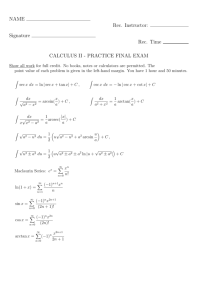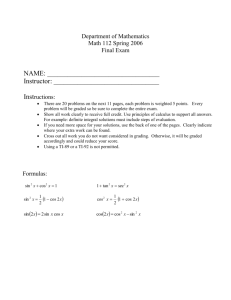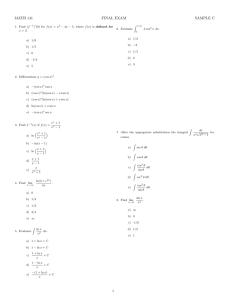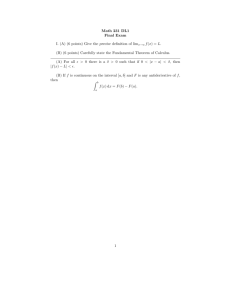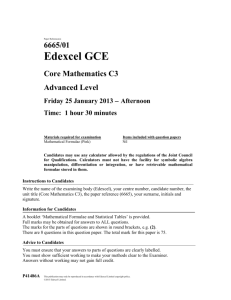Math 231 Practice Final Exam Problems.
advertisement
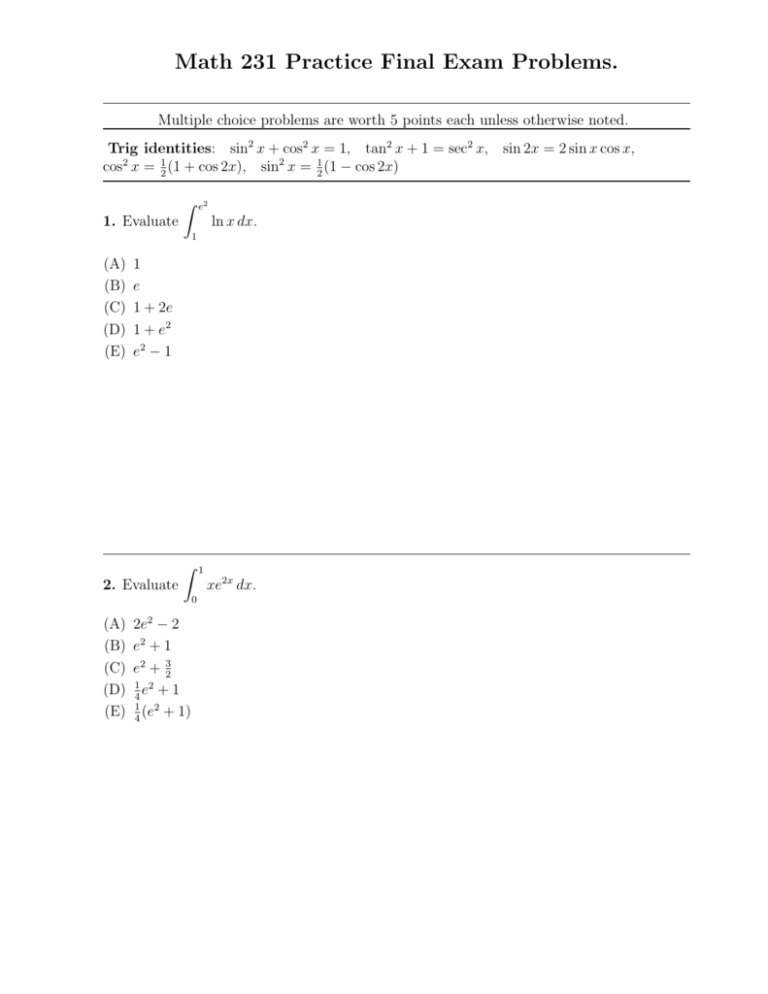
Math 231 Practice Final Exam Problems.
Multiple choice problems are worth 5 points each unless otherwise noted.
Trig identities: sin2 x + cos2 x = 1, tan2 x + 1 = sec2 x, sin 2x = 2 sin x cos x,
cos2 x = 21 (1 + cos 2x), sin2 x = 12 (1 − cos 2x)
Z
e2
ln x dx.
1. Evaluate
1
(A)
(B)
(C)
(D)
(E)
1
e
1 + 2e
1 + e2
e2 − 1
Z
2. Evaluate
0
(A) 2e2 − 2
(B) e2 + 1
(C) e2 + 32
(D) 14 e2 + 1
(E) 14 (e2 + 1)
1
xe2x dx.
Z
3. Evaluate
(A)
(B)
(C)
(D)
(E)
9x − 1
dx.
x2 − 1
4 ln |x − 1| + 5 ln |x + 1| + C
5 ln |x − 1| + 4 ln |x + 1| + C
6 ln |x − 1| + 3 ln |x + 1| + C
4 ln |x − 1| − 5 ln |x + 1| + C
6 ln |x − 1| − 3 ln |x + 1| + C
4.
Z After making the correct trig substitution, which does the following integral become:
1
√
dx.
x2 9 + x2
Z
cos2 θ
1
dθ
(A) 9
sin θ
Z
cos θ
1
(B) 9
2 dθ
sin
θ
Z
(C) 19 cos2 θ sin2 θ dθ
Z
cos3 θ
1
(D) 9
dθ
2
Z sin θ
(E) 19 cos θ sin θ dθ
Z
5. Find all values of p for which the following integral converges:
2
(A)
(B)
(C)
(D)
(E)
p<1
p≤1
p≥0
p>1
p≥1
6. Find the length of the curve y = 1 + 32 x3/2 , 0 ≤ x ≤ 1.
(A)
(B)
(C)
(D)
(E)
√
2 2−1
√
√
2 3 − 432
2/3
√
3 − 13
√
3 − 13
2
3
∞
1
dx.
x(ln x)p
Problems on this page are worth 2 points each
Mark C if the integral converges, and D if the integral diverges
Z ∞
x2
√
7.
dx
x7 + 14
0
Z
∞
8.
1
Z
9.
1
e−x + x
dx
(x + 2)2
1
1
0
|x| 3
dx
Mark C if the sequence {an } converges and D if it diverges
10. an =
n2 + n sin(n)
n2 ln(n) + n
11. an =
(ln n)50
√
n
12. an =
n + (−1)n n2
n2 + 1
Problems on this page are worth 2 points each
Mark A if the series converges absolutely.
Mark C if the series converges conditionally.
Mark D if the series diverges.
13.
∞
X
(−1)n 2n
n!
n=1
14.
∞
X
(−1)n ·
n=1
15.
n2
n3 + 7
∞
X
(−1)n cos(1/n)
n=1
16.
∞
X
n=2
5
n
−2
3
n
∞
X
52n
17. Find the sum of the series
.
5n+1
2
n=1
(A) 25/64
(B) 25/32
(C) 25/14
(D) 14/64
(E) 14/32
18. Find the Maclaurin series for the function
(A)
(B)
∞
X
(−1)n x2n−2
n=0
∞
X
n=0
(C)
(D)
(E)
(2n)!
(−1)n x4n
(4n)!
∞
X
(−1)n x4n+2
n=0
∞
X
n=1
∞
X
n=1
(2n)!
(−1)n x4n
(4n)!
(−1)n+1 x4n−2
(2n)!
1 − cos(x2 )
.
x2
19. Find the equation for the polar curve r = 4 sin θ in rectangular coordinates.
(A)
(B)
(C)
(D)
(E)
x2 + y 2 − 4 = 0
x2 + y 2 − 2x = 0
x2 + y 2 − 2y = 0
x2 + y 2 − 4x = 0
x2 + y 2 − 4y = 0
20. Find the total area enclosed by the polar curve r = sin(2θ).
(A)
(B)
(C)
(D)
(E)
π
π/2
π+1
π/2 + 1
1
Part II. Free response. Show your work, and circle your answers.
1. (18 Points) Consider the curve (shown below) defined by the parametric equations
x = cos3 (t),
y = sin3 (t),
0≤t≤π
(i) Set up but do not evaluate an integral which represents the area under the curve.
(ii) Set up but do not evaluate an integral which represents the length of the curve.
(iii) Evaluate the integral from the last part to find the actual length.
2. (18 Points)
(i) Give the Maclaurin series for the function cos x − 1.
(ii) Use series to evaluate the limit
lim
x→0
No credit for using a different method.
Z
cos x − 1
.
x2 ex
1
(cos x − 1) dx to within .001.
(iii) Estimate
0
You do need not need to simplify your answer at all. But you must justify the accuracy.
3. (18 Points) (i) Find the Taylor series for f (x) = xex centered at 0.
(ii) Find the degree two Taylor polynomial T2 (x) for f (x) = xex centered at 0.
(iii) T2 (x) is used to approximate f (x) in the range 0 ≤ x ≤ 1/2. Estimate the maximum
error in this approximation (you do not need to simplify your answer).
4. (18 Points)
√
(i) Make a careful sketch of the polar curve r = 1 + 2 cos θ on the polar axes. Begin by
making a careful rectangular sketch on the axes to the left. Indicate all important features
of your sketches, including all important angles.
r
Q
(ii) Find the slope of the tangent line to the polar curve at the point where θ = π/2.
(iii) Set up and simplify but do not evaluate an integral which represents the total length
of the polar curve.
5. (8 points) Consider the power series
∞
X
(x + 1)n
n=0
(i) Find the radius of convergence.
(ii) Find the interval of convergence.
n+1
.


